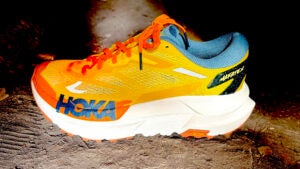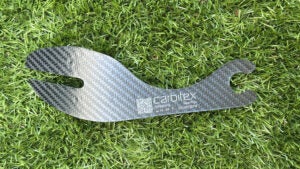New perk: Easily find new routes and hidden gems, upcoming running events, and more near you. Your weekly Local Running Newsletter has everything you need to lace up! Subscribe today.
If you’ve been following the evolution of road running shoes over the past eight years, you’ve heard of super shoes. These highly cushioned racing shoes combine advanced foam with a carbon-fiber plate embedded in the midsole. The genre was born in 2017 with the launch of Nike’s Vaporfly 4%, a shoe that disrupted the sport with bold claims of improved running economy.
A 2018 study proved the claim true, showing that 18 highly trained runners all experienced an average 4% reduction in the energy cost of running when running in the Vaporfly. The response was immediate: runners chasing marginal gains flocked to get a pair while competing brands rushed to develop carbon-plated contenders of their own.
Note that while the plate was initially thought to act like a spring, subsequent studies have shown that it is the thick foam’s explosive, trampoline-like action that gives super shoes their boing, and even making multiple cuts in a plate didn’t significantly affect the shoe’s impact on economy. That doesn’t mean the plate is superfluous: its role appears to involve engaging more foam, moderating the foam’s squish, and helping direct the rebound effectively. The plate and foam interact in ways not fully understood, but together add up to more than the sum of each’s effect, such that 1 + 1 = 3.
As brands poured their energy into creating the fastest road racing shoes, trail footwear saw little change. It took six years after the launch of the Nike Vaporfly 4% for carbon fiber plates to finally make their way into trail shoes. The first trail shoe to have a stiff, curved carbon fiber plate embedded in the midsole was the 2021 North Face Flight Vectiv, which got mixed reviews, especially from those who took it on technical terrain. Since then, plates in trail shoes have become more popular, with multiple brands, including Hoka, Nike, Adidas, and Saucony, all joining the game.
Solving for Trail’s Unpredictable Terrain
But adding a plate to a trail running shoe is far more complicated than putting one into a road shoe. Trails are unpredictable: rarely flat, often littered with rocks, roots, mud, and prone to sudden changes in landing surfaces and slope. In these conditions, a stiff plate in the sole can quickly go from performance enhancer to liability, tipping landings and bouncing push-offs in unproductive directions.
Trail shoe designers wanting to get carbon in their kicks faced a new challenge: how to harness the propulsive benefits of a plate seen in road shoes without compromising stability or surefootedness on uneven terrain. Trail runners wanted to know, given these competing priorities, can they expect the same performance gains seen on the road?
Junus Khan, founder of Carbitex, a leading supplier of carbon plates for running shoes, explains that in trail footwear, a plate is just one component in a much larger design equation. You have to build around the shoe’s intent: is it meant for ultra distances or short, punchy climbs? Is it built for technical trails or smooth fire roads? That context shapes everything when it comes to plates in trail shoes.
Unlike in road shoes, where propulsion is the primary goal, in trail shoes, a plate may be designed to serve multiple purposes. “There’s a protection aspect, there’s a propulsion aspect, and there’s a stability aspect,” Khan explains. “Depending on what the overall composition of the shoe is, a plate can facilitate that.”.

One example of this is the newly released Hoka Mafate X—a carbon plate-upgraded version of Hoka’s first trail shoe, the Mafate—compared to the more race-oriented Hoka Tecton X3. Both shoes feature carbon-fiber plates in the midsole, but each uses them for a different purpose.
Colin Ingram, VP of Innovation at Hoka, explains that the goal of the recently released Mafate X was to maximize long-distance performance. A wide, rigid H-shaped plate that forks on each end and has a shallower curve was added to enhance stability. In contrast, the Tecton X3 has two parallel, independent plates, engineered primarily for propulsion and optimized to enhance speed and agility.
Material, Shape, and Rigidity
Shoe designers have several tools at their disposal to fine-tune how a plate performs. The composition, shape, and flexibility of the plate all play critical roles in determining how it functions within the overall shoe design and influences the runner’s experience.
The three most common options in material—carbon fiber, nylon, and TPU—each come with their own trade-offs. Carbon is the lightest, thinnest, and stiffest of the three, offering maximum responsiveness at the lowest weight, but at a higher cost, so it’s typically reserved for premium trail shoes. On the other hand, a nylon or TPU plate may need four or five times the thickness of a carbon plate to achieve similar stiffness, which increases weight, but comes at a lower cost.
Materials and how they are woven or molded also affect the rigidity of a plate, which plays a crucial role in its performance. A 2021 study examining energy expenditure and biomechanics found that in road running shoes, curved plates with greater longitudinal bending stiffness had the most significant effect on the mechanics of foot and ankle joints and likely has a significant role in improving running economy. But rigidity makes a shoe’s forward roll more prescriptive, and reduces its adaptivity to varied footstrikes.
Another lever designers can play with is the plate’s shape, such as whether it is scooped, flat, or has slots or forked tines. According to Ingram, “Most of the shoes out there with that true scoop shape are built for speed, efficiency, and fast times.” Flatter plates, like the one seen in the Mafate X, are more designed for comfort, stability, and protection for long outings.

As designers worked to adapt plates for the trail, they found the solid, rigid curved plates used in road shoes lacked the adaptability and proprioceptive feel required for navigating the uneven, unpredictable nature of off-road terrain. To address this, designers use forked or segmented plates and less rigid materials that can flex and move with the midsole, providing stability and agility without compromising propulsion.
A Question of Speed and Stride
Not everyone is convinced that even trail-adapted embedded plates can enhance performance in trail shoes, however. When Salomon set out to design its latest trail racing model, the S/Lab Ultra Glide, the team conducted a study to determine whether a plate provided any performance benefits. They tested 12 non-elite male runners on a treadmill using two nearly identical prototype shoes, one with a carbon plate and one without, the only variable being the presence of the plate. They had each runner perform tests on a flat surface and a 10% incline. They found that speed had a significant role in whether the plate improved running economy, and even elite trail runners would not be sustaining high enough speeds throughout ultra races long enough to meet that threshold and realize benefits. In response to their study, the S/Lab Ultra Glide does not have a plate in its thick stack of responsive foam, but relies on specific geometry to provide stability and moderate the foam’s squish and response.
Unfortunately, because this and other studies on carbon fiber shoes have been conducted using road shoes on controlled treadmill surfaces, we have to be cautious when applying their conclusions to trail running, where the terrain is far more varied. That said, the studies’ results make it reasonable to assume trail runners are more likely to experience the performance benefits of plated shoes at faster paces on smoother terrain like fire roads, than when running slower and on highly technical trails.
A Role as Varied as the Trail
While the benefits continue to be debated, most brands and runners seem to agree that plates do serve a meaningful role in trail shoes, albeit often a different one than played by plates in road super shoes. While they may enhance running economy in certain trail situations, their true value likely lies in how they work in tandem with the shoe’s foam and geometry to contribute to propulsion, stability, protection, or all three, depending on the design intent.
When shopping for a plated trail shoe, don’t assume that the presence of a plate automatically means it’s built for speed or improved running economy. “It really isn’t a one-size-fits-all situation. It just comes down to what a brand is trying to achieve,” Khan notes.
